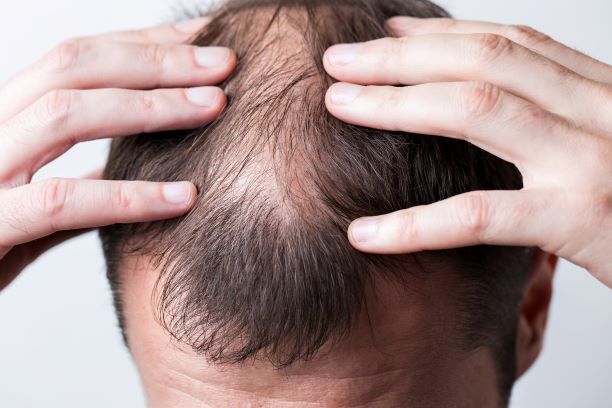
Diseases that cause hair loss
Diseases – they are often the problem of hair loss. Hair loss is a problem faced by men and women all over the world. Sometimes, it is caused by a poor diet low in valuable micronutrients, chronic stress, improper care, medication or even the weather. But sometimes the cause of hair loss lies deeper – in a disease. Let’s take a look at the diseases that most often cause thinning and hair loss.
THYROID DISEASE – HASHIMOTO
When the levels of hormones produced by the thyroid gland rise above normal (hyperthyroidism) the metabolism increases. This results in many changes in the body. In the case of hair, this change results in an acceleration of its growth cycle. The result is very thin, brittle, fragile hair that ages quickly. Hyperthyroidism can cause alopecia areata, in which hair falls out in clumps, forming hairless fields separated by the scalp, as well as even baldness of the entire scalp.
Hashimoto’s disease is a specific chronic inflammation of the thyroid gland. It is an autoimmune disease that can be associated with hair loss. Hashimoto’s is a disease associated with an enlarged thyroid gland. It results in a feeling of constant fatigue as well as hair loss. During the course of the disease the blood supply to the head is poor and the level of thyroxine, a hormone produced by the thyroid gland, decreases significantly. The result is thinning, brittle and fragile hair.
SYSTEMIC LUPUS
It is an autoimmune disease, which means that during its course the body attacks itself. The disease is characterised by increased hair loss, skin changes, pain and swelling in the joints, erythema on the face and hypersensitivity to light.
POLYCYSTIC OVARY SYNDROME
One of the symptoms of this condition is androgenetic alopecia in women. This is male pattern baldness, which in women usually manifests itself as diffuse thinning on the top of the head. The disease is very often accompanied by irregular and scanty menstruation, increased acne, unjustified weight gain and excessive hair on the face, thighs, buttocks, back.
SCALP PSORIASIS
Psoriasis is a skin disease that does not directly cause baldness, but indirectly affects the fact of hair loss. This is because inflammation and irritation of the hair follicles, which is one of the many effects of psoriasis, cause hair loss.
SEBORRHOEIC DERMATITIS. DANDRUFF
Seborrhoeic dermatitis is a condition of excessive sebum production by the sebaceous glands caused by an excess of androgens and progesterone. Seborrheic dermatitis very often affects young men after the age of 18 and is therefore one of the most frequent causes of hair loss in teenagers and twenty-year-olds. The cause of hair loss is seborrhea and the resulting dandruff. The situation is not improved by numerous keratoses and inflammation of the hair root as a consequence of this disease.
Seborrheic dermatitis is often accompanied by dandruff. This is known as dandruff. It takes the form of yellow scales covering the scalp. Dandruff causes severe itching and inflammation and over time develops into hard, very unpleasant scabs. If left untreated, it will spread throughout the scalp and may even result in complete hair loss.
ANEMIA
Anaemia, also called anaemia, is a pathological condition in which the number of red blood cells (erythrocytes) or the amount of haemoglobin they contain is insufficient for adequate oxygenation of the tissues. The first symptom of iron deficiency is usually apathy and unjustified, continuous fatigue. The complexion looks unhealthy, the skin is dry and unpleasant to the touch. The hair is fragile, with split ends, brittle and falls out in excessive numbers.
DIABETES
Increased glucose levels constrict the blood, so the blood is prevented from flowing freely, which means that the hair follicle does not receive the nutrients it needs. People with diabetes suffer from damage to the blood vessels that nourish the hair follicles – hair growth is inhibited and the blood-deprived hair grows more slowly or falls out.
ALOPECIA AREATA
It is an autoimmune disease involving loss of hair on the head, face and body. This type of alopecia is less common affecting 2% of the world population. This chronic inflammatory disease, in the course of which hair follicles are damaged, appears at any time and can be psychologically very debilitating. It leaves widespread patches on the scalp, similar in shape to patches.
ATOPIC DERMATITIS
It is a skin disease that involves a genetically determined abnormal reaction to allergens. It manifests itself by unusual dryness of the skin and very strong itching. The hair follicles in the skin affected by atopic dermatitis are insufficiently rooted and weak, a situation aggravated by severe itching that causes a strong urge to scratch the skin.
BORELIOSIS
Lyme disease is a dangerous, potentially fatal disease that attacks the nervous system and many internal organs as well as the skin of humans. During the course of the disease the hair also suffers and falls out in very large amounts.
ADDISON’S DISEASE
It is an endocrine disorder caused by a chronic deficiency of hormones produced by the adrenal cortex. The old name of this disease (cisavica) refers to the very characteristic darkening of the skin occurring in people suffering from this type of disorder.
TRICHOTILLOMANIA
JIt is a mental disorder which manifests itself by uncontrollable pulling out of hair, most often from the head, but also from eyebrows, less often from eyelashes and other parts of the body.
CANCER
Cancer diseases are very often connected with hair loss. In the case of cancerous diseases we can speak of two types of alopecia:
– alopecia as a consequence of disease
- is usually not reversible
- occurs most often in the case of skin cancers affecting the scalp, which also destroy the hair follicles
– alopecia as a consequence of disease treatment methods
- in this case the hair growth stops
- this type of baldness is reversible after the end of the treatment.

